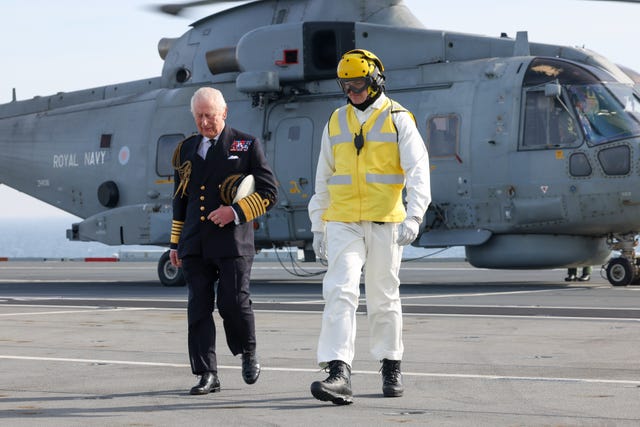
The Royal Navy’s flagship HMS Prince of Wales is making final preparations for a diplomatic and training mission of the other side of the world.
The aircraft carrier will sail from Portsmouth Naval Base on April 22 as head of a carrier strike group made up of warships and supply ships before heading firstly to the Mediterranean for security exercises and then on to the Indo-Pacific region.
The group will conduct exercises and port visits with partners including the US, India, Singapore and Malaysia, before joining 19 partner nations for Exercise Talisman Sabre near Australia and then training alongside the Japanese Self Defence Forces and conducting a port visit to India.
A total of 2,500 Royal Navy personnel and 592 from the Royal Air Force will be involved in the eight-month deployment which will also feature 900 British Army personnel joining them for exercises.
The deployment, called Operation Highmast, is aimed at exercising with allies in the region and enabling UK companies to participate in trade events in the Indo-Pacific region which last year accounted for 17% of UK trade.
Defence Secretary John Healey said: “I want to thank the thousands of our armed forces personnel involved in the delivery of this immensely complex operation, demonstrating the UK’s world-leading capability to deploy a major military force around the world.
“This is a unique opportunity for the UK to operate in close co-ordination with our partners and allies in a deployment that not only shows our commitment to security and stability, but also provides an opportunity to bolster our own economy and boost British trade and exports.

“As one of only a handful of countries in the world able to lead a deployment of this scale, the Royal Navy is once again demonstrating its formidable capability while protecting British values and sending a powerful message of deterrence to any adversary.”
Armed forces minister Luke Pollard said: “Through this deployment of our carrier strike group and 4,000 service personnel, we will stand firm with our allies against those who challenge the international order, reminding the world that the security of the Euro Atlantic and Indo-Pacific are fundamentally indivisible.
“This isn’t just about hard power, it’s about building influence and opening new trade opportunities both for defence and other sectors of our economy which will deliver British jobs and growth.”
The carrier strike group is to be equipped with nine heavy lift drones to transport supplies between ships during the deployment, a job previously carried out by helicopter.

The all-electric uncrewed quadcopters – produced by Malloy Aeronautics, part of BAE Systems – will shift supplies weighing up to 68kg such as defence equipment, food and packages from home, at a top speed of 60mph.
Lieutenant Matt Parfitt of 700X Naval Air Squadron said: “There is a statistic from previous carrier strike deployments that shows 95% of stores transferred weigh less than 50kg. They could be anything from parcels from home to a vital engineering part.
“In the past we’d have used a helicopter if a part was urgently needed on another ship. This time we’re going to use a remotely piloted, uncrewed system instead.”
Twelve other nations are supporting the deployment, including Canada and Spain, with Norway providing a warship for the entire duration.
After the carrier strike group forms off the coast of Cornwall, HMS Prince of Wales will embark its 24 RAF F-35B Lighting fighter jets before initially being placed under Nato command for Exercise Neptune Strike.



Comments: Our rules
We want our comments to be a lively and valuable part of our community - a place where readers can debate and engage with the most important local issues. The ability to comment on our stories is a privilege, not a right, however, and that privilege may be withdrawn if it is abused or misused.
Please report any comments that break our rules.
Read the rules hereYou must verify your phone number before you can comment.
Please enter your phone number below, and a verification code will be sent to you by text message.
Please enter the six-digit verification code sent to you by SMS.
Your verification code has been sent a second time to the mobile phone number you provided.
Your verification code has been sent a third time to the mobile phone number you provided.
You have requested your verification code too many times. Please try again later.
Didn’t receive a code? Send it againThe code you entered has not been recognised.
Please try again
You have failed to enter a correct code after three attempts.
Please try again later.
Your phone number has been verified.
Your phone number has been stored with your account details. We will never use it for anything other than verifying that you are the legitimate owner of this account.